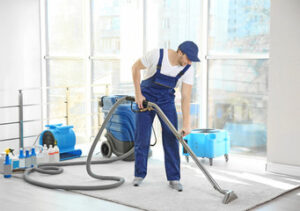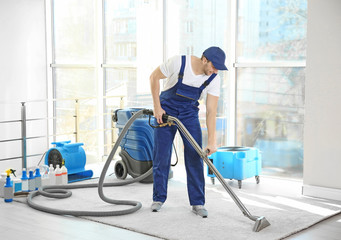Carpets act as giant air filters, trapping dirt and allergens in their fibers. Regular Carpet Cleaning El Dorado Hills CA eliminates these pollutants, boosting indoor air quality and helping carpets last longer. Routine carpet maintenance includes vacuuming 1-2 times per week and dealing with spills as quickly as possible. Stains should be blotted (not rubbed) as soon as they occur to minimize color changes and reduce staining.
 The most common cause of dirty carpets is dirt and debris tracked in from outside. This includes sand, pebbles, pet stains, and soil from shoes or boots. Regular vacuuming will help reduce surface dirt, but a deep clean is required to remove ground-in grime. Vacuum each room weekly and pay special attention to high-traffic areas. A lint roller will help capture pet hair and other small particles.
The most common cause of dirty carpets is dirt and debris tracked in from outside. This includes sand, pebbles, pet stains, and soil from shoes or boots. Regular vacuuming will help reduce surface dirt, but a deep clean is required to remove ground-in grime. Vacuum each room weekly and pay special attention to high-traffic areas. A lint roller will help capture pet hair and other small particles.
Stains caused by foods, beverages and other household products can also become a problem for carpets. If a stain is not treated promptly, it can penetrate the fibers of the carpet and become more difficult to remove.
A good carpet cleaner will have the ability to remove a wide variety of stains. This is especially important if you have children or pets in the home. A carpet cleaning company should be able to recommend a suitable cleaner for each type of stain.
It is always a good idea to test any DIY solutions on a small area of your carpet before using them. Some cleaning solutions can permanently stain or damage a carpet.
Many carpet manufacturers recommend using a professional-grade carpet shampoo machine to remove stubborn stains and restore your carpet to its original condition. Some companies use a rotary machine with spinning brushes or pads to agitate the carpet and release the cleaning solution. Others use a carpet extractor to spray water and a cleaning solution into carpets, which is then immediately removed with a powerful vacuum machine.
Before starting the actual cleaning process, a professional will put protective cover guards under furniture to prevent woodwork from being damaged. They will also look for objects such as coins, tacks or nails that could potentially damage the vacuuming equipment. The carpet is then thoroughly vacuumed and inspected.
The technician will decide on a proper chemical solution and cleaning method to treat the type of stain or soil found in the carpet. The technician may also apply a pretreatment solvent to loosen and dissolve soils that would otherwise be difficult to break down. The carpet is then steamed or hot water extracted, which can remove the majority of dirt from within the fibers of a carpet. The carpet will then be dried, which can take up to six hours in some cases.
Mold and Mildew
Mold and mildew both grow in damp areas, but they have distinct differences that affect your home and health. Mildew is a surface fungus, while mold grows deeper into its host and can destroy the item it eats away at. The difference between these two fungi also makes them treatable in different ways. Mildew is typically more easily removed from surfaces by a store-bought cleaner or a bleach solution and scrubbing brush. Mold is more complicated to deal with and requires professional testing and treatment.
Mold spores can be found in the air and may attach to moist, sheltered surfaces, such as paper products, cardboard, wood or drywall. They can also grow in soiled or dusty areas, such as the top of a dirty refrigerator, the bottom of a leaky basement or behind a discolored wall. If left unchecked, mold can spread to other areas of the house and may be toxic to humans.
The best way to prevent the growth of mildew is to keep soiled clothing and household items as clean as possible. Clean fabrics, including those made of synthetic fibers like acetate, acrylic or polyester, can resist mildew growth if they are regularly cleaned. Soaking soiled fabrics in warm water or cleaning them with a mildew remover can help eliminate stubborn mildew stains.
If you have a sensitive reaction to mildew, breathing in the spores may cause wheezing, itchy eyes, nose or throat and sneezing. People with more severe allergies or chronic lung problems are at risk of serious health issues, such as chest tightness or shortness of breath. Some common mildew fungi include: Aureobasidium, found in showers; Botrytis, a common kitchen mold; and Rhizopus, which is hazardous to those with nutritional deficiencies or existing health conditions. To prevent mildew and other fungi from growing in your carpet, keep humidity levels low and make sure indoor air is well ventilated. In addition, dry mopping or vacuuming often helps prevent moisture buildup. For mildew stains on carpet or upholstery, soak the stain overnight in a solution of 1 teaspoon of sodium perborate or powdered bleach with a pint (0.47 liters) of hot or lukewarm water (if safe for the fabric).
Allergens
Allergens like dust mite droppings, pet dander and mold spores are attracted to carpet fibers. When they are disturbed, such as when someone walks across the room or sits down on a chair, the allergens are dispersed into the air where they can be inhaled by people with hypersensitive immune systems. These people often experience allergic reactions, including coughing and sneezing.
The agitation of the human body as it inhales these allergens triggers the production of chemical compounds called histamines that attack the histamine receptors on the cells in the nose, throat and eyes. The irritation causes sneezing and coughing, which can be persistent. In severe cases, the histamines can cause asthma attacks.
Fortunately, there are steps you can take to minimize your allergy problems. Vacuum your carpet on a regular basis with a machine that has a HEPA (high efficiency particulate air) filter to remove the allergens from your home. You can also use a high-quality air purifier that is specially rated to capture and reduce mold, pollen and other allergens in your home. Encourage family members and guests to remove their shoes when entering the home to further prevent the buildup of unwanted allergens in your carpet.
Carpets that are frequently exposed to moisture promote the growth of mold and mildew, which can exacerbate allergy symptoms. You can help to avoid excessive moisture in your carpets by promptly addressing spills and using dehumidifiers or fans in areas that tend to get damp. In addition, you can opt for flooring such as tile, vinyl or hardwood that is less prone to molding and other moisture-related issues.
If you have allergies, make an appointment to have your carpet cleaned at least twice a year or as needed. A professional cleaning with a steaming technique and a HEPA filter will ensure that the majority of allergens are removed from your carpet before they can affect your allergy symptoms. In addition, you can take other preventative measures such as requesting that family members and guests remove their shoes when entering your home, cleaning up stains as soon as they appear and utilizing an anti-allergen vacuum or air purifier in rooms with carpeting.
Indoor Air Quality
Carpet acts like a giant filter, trapping many types of indoor air pollutants and preventing them from being released back into the breathing zone. However, it can only be effective if it is properly maintained. This includes regular vacuuming on a weekly or daily basis, spot removal on a daily basis and periodic extraction. This last process is important because it flushes the pollutants from the fibers rather than just pushing them deeper into the carpet where they can eventually be re-released.
When it comes to cleaning carpets, using the proper chemical solutions and equipment is also crucial. The chemicals used must be safe and they must also be thoroughly cleaned from the equipment afterward to prevent any harmful residues from being left behind on the carpet or in the air. This is especially true for shampooing, where the carpet must be rinsed completely to avoid leaving any toxic chemicals in the air.
The good news is that the vast majority of the chemicals used to clean carpet are relatively benign, and in fact, far less harmful than some of the chemicals used to keep hard flooring clean. However, it is still important to consider the health implications when choosing a carpet and, if possible, try to select green carpet made from materials that do not contain any toxic synthetic substances.
As a result, it is essential to have the carpet in your home regularly professionally cleaned. This will reduce the amount of dust mites, mold spores and other airborne pollutants that accumulate inside your carpet. Additionally, it is important to maintain good ventilation in the home by opening windows and running fans on a regular basis to bring fresh air in and allow dirty air to escape.
In summary, it is important to keep in mind that carpet is an integral part of your home and, with the right care, can be a very valuable asset for your family’s health. Just be sure to make good use of entry mats at every door to help keep the dirt and grime outside, and have your carpets cleaned on a regular schedule to reduce the amount of pollutants trapped in them.

